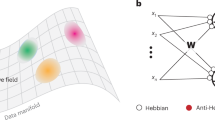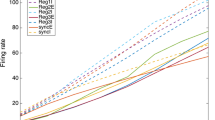Abstract
We discuss the ability of dynamic neural fields to track noisy population codes in an online fashion when signals are constantly applied to the recurrent network. To report on the quantitative performance of such networks we perform population decoding of the ‘orientation’ embedded in the noisy signal and determine which inhibition strength in the network provides the best decoding performance. We also study the performance of decoding on time-varying signals. Simulations of the system show good performance even in the very noisy case and also show that noise is beneficial to decoding time-varying signals.






Similar content being viewed by others
References
Amari S (1977) Dynamics of pattern formation in lateral-inhibition type neural fields. Biol Cybern 27:77–87
Dayan P, Hinton GE, Neal R, Zemel R (1995) The helmholtz machine. Neural Comput 7:889–904
Deneve S, Pouget A, Latham P (1999) Divisive normalization, line attractor networks and ideal observers. Adv Neural Inform Process Syst 11:104–110
Deneve S, Latham PE, Pouget A (2001) Efficient computation and cue integration with noisy population codes. Nat Neurosci 4:826–831
Friston K (2005) A theory of cotrical responses. Philos Trans R Soc B 360:815–836
George D, Hawkins J (2005) A hierarchical bayesian model of invariant pattern recognition in the visual cortex. Int Joined Conf Neural Netw 3:1812–1817
Gerstner W (2000) Population dynamics of spiking neurons: fast transients, asynchronous states, and locking. Neural Comput 12(1):43–89
Henry GH, Dreher B, Bishop PO (1974) Orientation specificity of cells in cat striate cortex. J Neurophysiol 37:1394–1409
Hinton GE (2007) Learning multiple layers of representation. Trends Cogn Sci 11:428–434
Hubel D, Wiesel T (1962) Receptive fields, binocular interaction and functional architecture in the cat’s visual cortex. J Physiol (Lond) 160:106–154
Li S, Wu S (2007) Robustness of neural coding and its implications on natural image processing. Cogn Neurodyn 1:261–272
Pouget A, Zhang K (1997) Statistically efficient estimations using cortical lateral connections. Adv Neural Inform Process Syst 9:97
Pouget A, Zhang K, Deneve S, Latham P (1998) Statistically efficient estimation using population coding. Neural Comput 10(2):373–401
Pouget A, Dayan P, Zemel R (2000) Information processing with population codes. Nat Rev Neurosci 1:125–132
Stringer S, Trappenberg T, Rolls E, Araujo I (2002) Self-organising continuous attractor networks and path integration: one-dimensional models of head direction cells. Netw: Comput Neural Syst 13:217–242
Trappenberg T (2002) Fundamentals of computational neuroscience. Oxford University Press, USA
Trappenberg T (2008) Dynamics of population decoding with strong inhibition. In: Rubin W, Fanji G, Enhua S (eds) Advances in cognitive neurodynamics. Proceedings of the International Conference on Cognitive Neurodynamics 2007, Springer
Wilson H, Cowan J (1972) Excitatory and inhibitory interactions in localized populations of model neurons. Biophys J 12:1–24
Wu S, Amari S, Nakahara H (2002) Population coding and decoding in a neural field: a computational study. Neural Comput 14:999–1026
Wu S, Amari S, Nakahara H (2004) Information processing in a neuron ensemble with the multiplicative correlation structure. Neural Netw 17:205–214
Acknowledgments
I thank Jason Satel for comments on the manuscript and Gregor Schöner for discussing the interpretation of decoding. This research was supported by NSERC (Canada).
Author information
Authors and Affiliations
Corresponding author
Rights and permissions
About this article
Cite this article
Trappenberg, T. Tracking population densities using dynamic neural fields with moderately strong inhibition. Cogn Neurodyn 2, 171–177 (2008). https://doi.org/10.1007/s11571-008-9046-0
Received:
Accepted:
Published:
Issue Date:
DOI: https://doi.org/10.1007/s11571-008-9046-0




